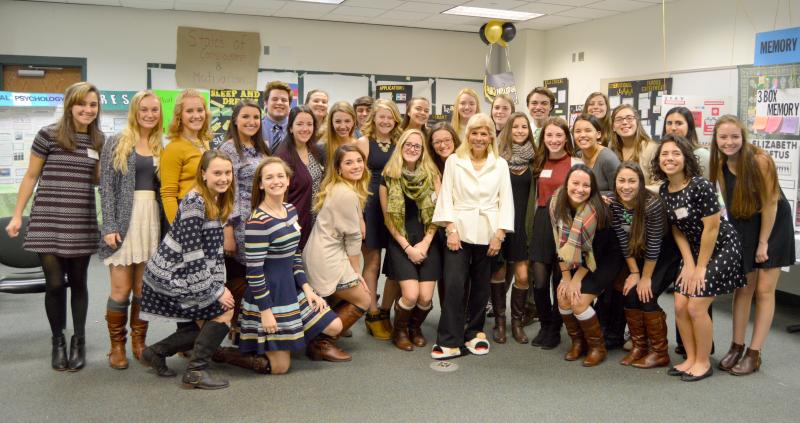Psychology fair highlights the brain, pitfalls of being human
The brain, with all its complexity, is impressionable and can sometimes play tricks on us. On Friday, Dartmouth High students taught fellow classmates just how susceptible to influence the brain can be.
Dartmouth High teacher Lynn Vincente’s advanced placement psychology classes joined forces for the 8th Annual Psychology Fair, which ran throughout the day on Jan. 8.
“Most people think psychology is where you come and talk about your feelings. That’s not what it is. Psychology is a science,” said Vincente.
Each student was tasked with choosing a topic, creating a poster and provided a demonstration to reinforce their subject. Each student’s project fell under the umbrella of seven basic themes of psychology, such as memory or neuroscience.
Students who pass the course will be eligible for college credit, and the course could help them out in the long run should they opt for a career in medicine.
“The pre-med exam is now twenty-five percent psychology and behavioral science,” said Vincente. “It’s about taking care of the full person, and it’s important to know concepts in psych.”
To help make concepts easier to understand for the fair’s audience, namely other students from the school’s social studies classes, the psychology students prepared interactive demonstrations. Because many of the concepts on display were already presented in class, they were tasked with developing their own interactive demos.
Senior Reid Santos, 17, worked as part of the “Sensation and Perception” group. She taught attendees how the brain is able to detect smell and taste, and what the brain will do with that information.
She explained that two parts of the brain interact with scents in the environment. The frontal lobe deals with reasoning, which helps humans gather information based on smell. If you smell a pizza, for instance, the frontal lobe helps you determine if there’s pepperoni on the pizza or if the cheese has been burnt.
“The other side is the limbic system, which deals with memories and emotions,” said Santos. “If you smell something from your childhood, it lights up and brings you to the memories, basically.”
Santos’ demonstration showed how sight, smell and taste work in tandem to help people make sense of the world – and how quickly that information can become muddled when one sense is removed from the equation.
She blindfolded participants and asked them to smell an assortment of foods and objects to see if they could determine whether what they were smelling was edible or not. Without sight, it can be tricky for some to determine if things like rubber bands, candy scented candles or Gatorade powder is something worth ingesting.
Another group tasked participants to identify a thief. In a short video clip, two women sit on a park bench. Suddenly, a man wearing a hat darts past and snatches the pocketbook resting between the two.
The viewer is then shown six photographs of men who could possibly be the perpetrator. It turns out, however, that none of the six committed the crime.
“Usually, in a line-up, the person who did it isn’t there, so people will falsely accuse others,” said senior Sam Medeiros, 17.
She said that’s largely due to the stress of the moment and because people in that situation can be easily influenced.
“Someone earlier today said that one the people should be picked because he looks scary. That’s an example of someone feeling the pressure from the game itself,” said senior Erin Varnum, 17.
“When we learned this chapter in class, our teacher showed us an Oprah episode where someone came in and took someone’s purse, and then they took members from the audience who said they could identify who did it. It turned out that they couldn’t. No one could identify the person,” she said.
Students spent about five hours teaching others about the brain.
“It’s been fun going around the room and learning pieces of it,” said Santos. “It’s a nice review for everyone.”














